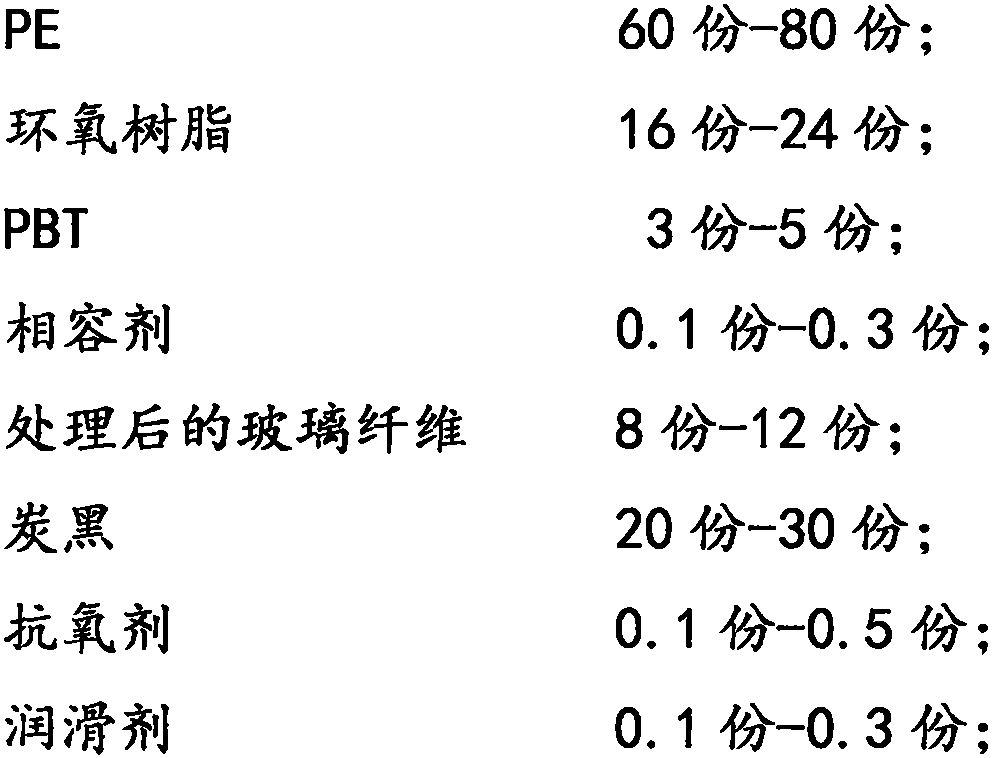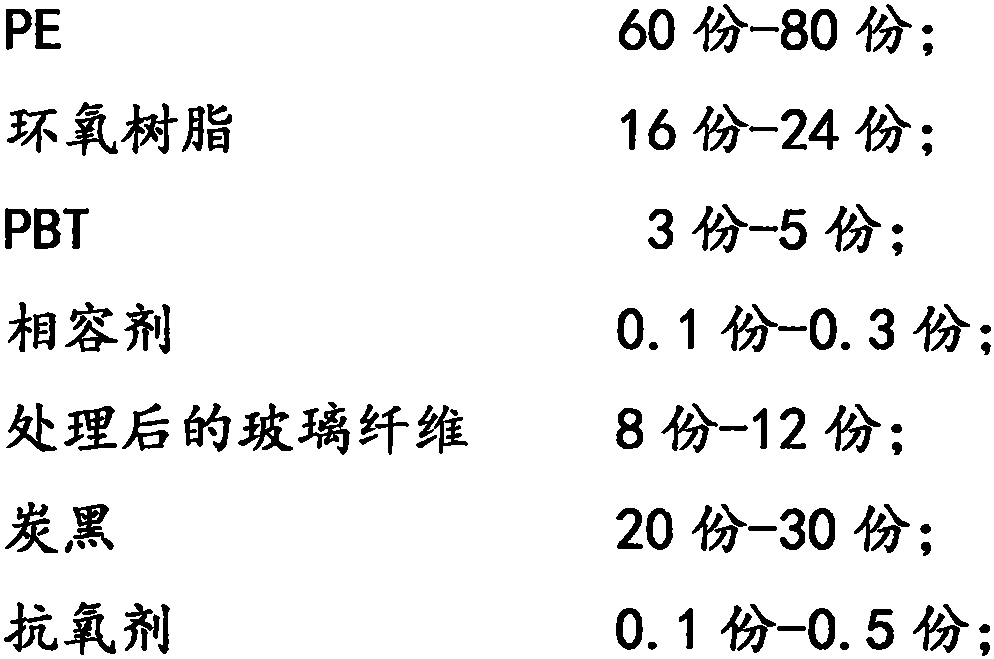Anti-static PE composite material
A composite material and antistatic technology, applied in the field of antistatic PE composite materials, can solve the problems of low carbon black content and application limitations, and achieve the effect of reducing particle size, improving mechanical properties, and promoting heterogeneous nucleation.
- Summary
- Abstract
- Description
- Claims
- Application Information
AI Technical Summary
Problems solved by technology
Method used
Image
Examples
Embodiment 1
[0025] (1) Weigh 60 parts of PE, 16 parts of epoxy resin, 3 parts of PBT, 8 parts of glass fiber, 20 parts of carbon black, 0.1 part of PE-g-MAH, 0.1 part of Irganox168, 0.1 part of calcium stearate, mix and stir Uniformly, to obtain a mixture;
[0026] (2) extruding and granulating the mixture obtained in the step (1) to obtain the PE composite material P1.
[0027] Among them, the twin-screw extruder includes six temperature zones arranged in sequence, the temperature of the first temperature zone is 140°C, the temperature of the second temperature zone is 170°C, the temperature of the third temperature zone is 170°C, and the temperature of the fourth temperature zone is 170°C. The temperature in the temperature zone is 170°C, the temperature in the fifth temperature zone is 170°C, the temperature in the sixth temperature zone is 170°C, the head temperature of the twin-screw extruder is 170°C, and the screw speed is 200r / min.
Embodiment 2
[0029] (1) Weigh 80 parts of PE, 24 parts of epoxy resin, 5 parts of PBT, 12 parts of glass fiber, 30 parts of carbon black, 0.3 part of PE-g-MAH, 0.1 part of Irganox1010, 0.2 part of Irganox1330, 0.2 part of Irganox168, 0.3 Parts of sodium stearate are mixed and stirred evenly to obtain a mixture;
[0030] (2) Extruding and granulating the mixture obtained in step (1) to obtain PE composite material P2.
[0031] Among them, the twin-screw extruder includes six temperature zones arranged in sequence, the temperature of the first temperature zone is 160°C, the temperature of the second temperature zone is 200°C, the temperature of the third temperature zone is 200°C, and the temperature of the fourth temperature zone is 200°C. The temperature in the temperature zone is 200°C, the temperature in the fifth temperature zone is 200°C, the temperature in the sixth temperature zone is 200°C, the head temperature of the twin-screw extruder is 200°C, and the screw speed is 260r / min.
Embodiment 3
[0033] (1) Weigh 70 parts of PE, 20 parts of epoxy resin, 4 parts of PBT, 10 parts of glass fiber, 25 parts of carbon black, 0.2 parts of PE-g-MAH, 0.3 parts of Irganox1330, 0.2 parts of potassium stearate, mix and stir Uniformly, to obtain a mixture;
[0034] (2) Extruding and granulating the mixture obtained in the step (1) to obtain the PE composite material P3.
[0035] Among them, the twin-screw extruder includes six temperature zones arranged in sequence, the temperature of the first temperature zone is 150°C, the temperature of the second temperature zone is 185°C, the temperature of the third temperature zone is 185°C, and the temperature of the fourth temperature zone is 185°C. The temperature in the temperature zone is 185°C, the temperature in the fifth temperature zone is 185°C, the temperature in the sixth temperature zone is 185°C, the head temperature of the twin-screw extruder is 185°C, and the screw speed is 230r / min.
PUM
 Login to View More
Login to View More Abstract
Description
Claims
Application Information
 Login to View More
Login to View More - R&D
- Intellectual Property
- Life Sciences
- Materials
- Tech Scout
- Unparalleled Data Quality
- Higher Quality Content
- 60% Fewer Hallucinations
Browse by: Latest US Patents, China's latest patents, Technical Efficacy Thesaurus, Application Domain, Technology Topic, Popular Technical Reports.
© 2025 PatSnap. All rights reserved.Legal|Privacy policy|Modern Slavery Act Transparency Statement|Sitemap|About US| Contact US: help@patsnap.com



